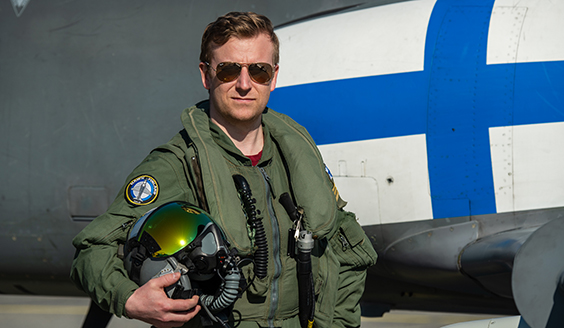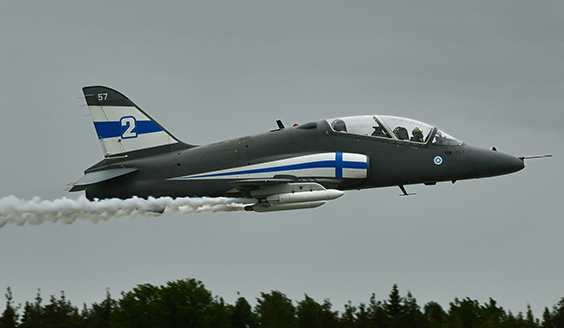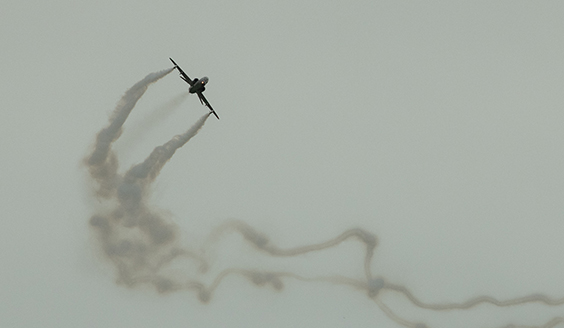Horizontal Rolls and Vertical Dives at 8 Gs
Introducing the Air Force season 2022 Hawk solo display pilot Captain Eemeli Vähäsöyrinki of the Air Force Academy’s Fighter Squadron 41.
The solo flown with a Finnish Air Force Hawk jet trainer demonstrates the plane’s performance including agility features. One of the season’s highlights for Eemeli Vähäsöyrinki is the Royal International Air Tattoo in the United Kingdom where the Finnish Air Force Hawk solo is shown for the first time.

Who are you and what are your duties at Fighter Squadron 41?
I am Captain Eemeli Vähäsöyrinki. I come from Sotkamo and I am 35 years old. I started as a conscript in 2006 and entered the Military Academy in 2007. I got my first touch with fighter flying in 2010 when I moved on to the Hawk, and from 2013 I have flown the Hornet. In 2019 I was assigned to the Air Force Academy to the duties of air combat instructor, and since then I have operated with both the Hornet and the Hawk.
I actually work as the Tactics Office Chief in Fighter Squadron 41, and one of my duties is to give air combat instruction. My fighter flying experience includes around 650 hours with the Hornet and 600 hours with the Hawk.
How did you become an Air Force pilot?
I never really thought about a fighter pilot career before joining the army. To me it was a profession that seemed unattainable. Instead, I aimed for medical or sports science studies. I also played football seriously and dreamt of becoming a professional player. At that time, I was studying in Salpausselkä sports-oriented upper secondary school in Lahti.
In military service I did want to do something interesting so I applied to the Pilot Reserve Officer Course. I enjoyed the military and flying the Vinka. During my one-year service, the dream of a fighter pilot career became tangible, and I put every effort to doing the service and gaining admission to the Military Academy. After having been selected to the Military Academy, my career choice and goal to fly the Hornet fighter were clear. The time in the Military Academy included studies at Santahamina and flight training in the Air Force Academy and Training Air Wing at Kauhava. It was a challenging but very interesting time.
What is it like to work as a fighter pilot?
I think I made the right choice and have really enjoyed every day at work. The most fascinating thing about this job is the fact that you are never done learning and there’s always something to improve. This sort of attitude is also essential to a fighter pilot to keep up with recent advances. The development of aircraft-specific systems, tactics and weapon technology requires constant effort every day. My work is very demanding but at the same time extremely fascinating.

What is this year’s display like?
The Hawk solo was created together with the previous years’ display pilot, Captain Sampsa Kaikkonen. The goal of the sequence is to manoeuvre close to the crowds and showcase the Hawk’s maximum performance and its special characteristics such as fast aileron rolling when a plane rotates about its longitudinal axis very rapidly. The Hawk is an enjoyable plane to fly because its swept-wing form retains energy – speed - efficiently and flight control surfaces respond to the pilot’s command very easily.
Tell us a few manoeuvres that will be seen in the display.
The sequence includes traditional aerobatic manoeuvres such as spectacles, a Cuban and an oblique loop as well as more special manoeuvres showing off the Hawk’s flight characteristics such as a four-point aileron roll, Derry turn, double barrel, double aileron roll and barrel roll with the landing gear extended at the top.
How do you plan the Hawk display sequence?
The planning process is based on the goals. The most important point is what we want to display. We also supplement the rough plan by adding the previous years’ manoeuvres that we find captivating. We prepare three display sequences for different weather conditions: good, medium and low weather routines, each of which includes specified minimum requirements for the ceiling and visibility.
When the plans are ready, we will first practise and validate them in the simulator. Only after that the first flight is conducted. It is flown at a minimum altitude of 300 metres to ensure flight safety. In case minor changes in the display are made, the altered routine will be operated at the same minimum altitude. When the display sequence has been finalised, the minimum altitude will become 150 metres where the second so-called training flight is flown. On the training flight, the previous year’s display pilot rides the back seat as an instructor. Then we move on to using the minimum of 100 metres and fly two training sorties at this final altitude. After all these stages the display pilot is ready to practise on his own. The supervisor of display training is always a skilled flight instructor who is able to give valuable advice after each flight.

Which are the unique characteristics of the Hawk for display flying?
By its flight characteristics Hawk jet trainers have remained nearly as such for the 40 years the Air Force has operated with them. However, the cockpit, some displays and systems have been modified greatly to meet the modern air warfare and fighter training requirements. The Hawk is a highly agile aircraft with precise steering capability. In other words, it responds to the pilot’s commands rapidly and accurately.
As I mentioned before, the Hawk has the capability of collecting and retaining energy (speed) extremely well. That’s why the aircraft as a jet trainer tolerates surprisingly high load factors or Gs. In my display flight the horizontal turns and recoveries from the vertical dives are flown with the G-force varying from six to eight. The speed of these manoeuvres is about 600 to 800 km/h.
The Air Force Hawk solo display will be seen for the first time in the world’s biggest air show - Royal International Air Tattoo. How does it feel?
This is my first display year and, right away, I have an opportunity to fly for hundreds of thousands of spectators. I’m not used to that, but I just have to train the sequence fully so that I don’t need to stress about it. Personally, it will be a great and definitely unforgettable experience. I’m looking forward to it.
Read more about Air Force’s display flying:
Solo Display Flight 2022 Showcases Limits of Hornet
Midnight Hawks Offer Diamond and Vertical Manoeuvres
Follow the Air Force on social media:



